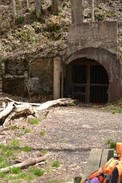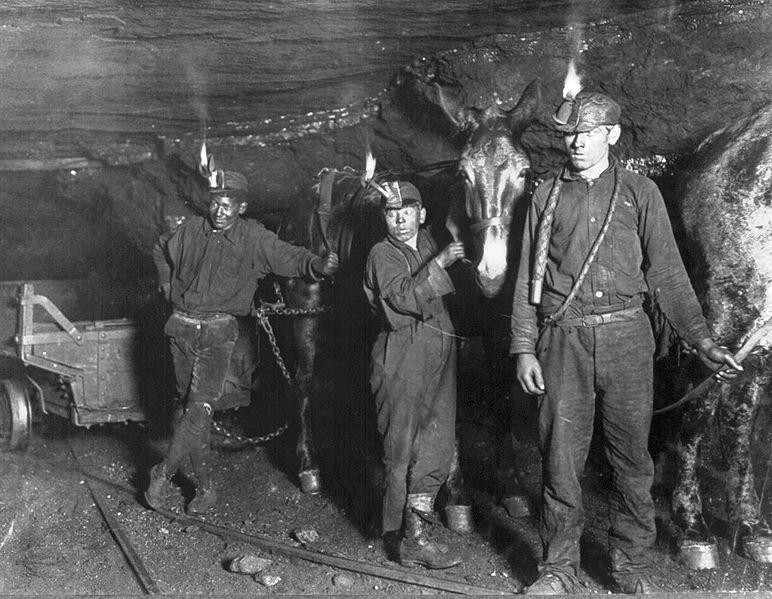Hawks Nest Coal Strike
Introduction
Text-to-speech Audio
In 1880 the West Virginia militia was used for the first time to stop a coal mine strike. The clashing of union and nonunion workers in the Coal Valley and Hawks Nest mines led the unionized works to halt work. After the strikers threatened violence to workers in neighboring mines, Governor Henry Matthews called in the state militia to arrest miners and break up the strike. The events at Hawks Nest and Coal Valley set a president for the handling of future mine strikes. The Hawks Nest Rail Trail offers a view of the Mill Creek Colliery Mine which was involved in the strike.
Images
Mill Creek Mine from Hawks Nest Rail Trail

West Virginia coal miners from the early 20th century

Backstory and Context
Text-to-speech Audio
In January of 1880, one of West Virginia's first coal miners strikes began in Coal Valley, what is now Montgomery. Strikers worked for the Hawks Nest Coal Company in Coal Valley and argued that the work of the mine unions was being undercut by the company's nonunionized workers from the nearby Hawks Nest mines. The Coal Valley workers tried to negotiate better conditions and pay. The strikers were pressured by the coal operators who were striking in Kanawha County mines around the same time for better pay. The coal operators in Kanawha County hoped to persuade the C&O Railway Company to build more liens and run more cars through the Kanawha Valley by slowing work in the mines of Fayette County.
Then Governor Henry Mathews feared that violence would erupt as a result of the strike. Matthews was wary of strike violence because of a violent railroad strike in the Martinsburg area not long before. After several Coal Valley miners traveled to Hawks Nest mines to threaten other miners, the state felt that action was needed. In an effort to halt the strike and prevent violence, Governor Matthews attempted to convince Sheriff C.H. McClung of Fayette County to intervene. McClung feared a backlash from voters and refused to get involved in the conflict. Instead, Matthews sent in a militia group from Charleston and Lewisburg on McClung's recommendation.
A total of 25 miners were arrested by the militia and held by Sheriff McClung, each of whom was charged with unlawful interference. The success of militia's efforts to halt the strike was felt by many of those involved. This strategy was repeated by officials for strikes in many subsequent years, including the 1894, 1902, and 1912 strikes. During WWI, the militia was sent abroad to fight and the state formed a police division in 1919 specifically to quell mine related violence.
Several participants in the events rose to prominence after the strike. Emanual Willis Wilson defended the strikers in the Fayette County Circuit Court and went on to become a governor. Militia commander John W.M. Appleton would rise to the rank of adjutant general in West Virginia. Most famously, William Nelson Page, a Kanawha County coal operator, formed the Company C of the West Virginia National Gaurd's 2nd Regiment and served for 20 years as a militia leader.
One entrance to the Hawks Nest Rail Trail begins at this location. Along the trail, hikers can view the entrance to the abandoned Mill Creek Colliery mine which was involved in the strike.
Then Governor Henry Mathews feared that violence would erupt as a result of the strike. Matthews was wary of strike violence because of a violent railroad strike in the Martinsburg area not long before. After several Coal Valley miners traveled to Hawks Nest mines to threaten other miners, the state felt that action was needed. In an effort to halt the strike and prevent violence, Governor Matthews attempted to convince Sheriff C.H. McClung of Fayette County to intervene. McClung feared a backlash from voters and refused to get involved in the conflict. Instead, Matthews sent in a militia group from Charleston and Lewisburg on McClung's recommendation.
A total of 25 miners were arrested by the militia and held by Sheriff McClung, each of whom was charged with unlawful interference. The success of militia's efforts to halt the strike was felt by many of those involved. This strategy was repeated by officials for strikes in many subsequent years, including the 1894, 1902, and 1912 strikes. During WWI, the militia was sent abroad to fight and the state formed a police division in 1919 specifically to quell mine related violence.
Several participants in the events rose to prominence after the strike. Emanual Willis Wilson defended the strikers in the Fayette County Circuit Court and went on to become a governor. Militia commander John W.M. Appleton would rise to the rank of adjutant general in West Virginia. Most famously, William Nelson Page, a Kanawha County coal operator, formed the Company C of the West Virginia National Gaurd's 2nd Regiment and served for 20 years as a militia leader.
One entrance to the Hawks Nest Rail Trail begins at this location. Along the trail, hikers can view the entrance to the abandoned Mill Creek Colliery mine which was involved in the strike.
Sources
West Virginia Encyclopedia. January 12, 1880: W.Va. National Guard Puts Down the First Coal Strike. WV Public Broadcasting. January 12, 2018. Accessed March 27, 2019. https://www.wvpublic.org/post/january-12-1880-wva-national-guard-puts-down-first-coal-strike#stream/0.
March 11, 1881: Use of state militia to put down Hawks Nest coal strike. West Virginia Division of Culture and History. . Accessed March 27, 2019. http://www.wvculture.org/history/timetrl/ttmar.html#0311.
Bailey, Kenneth R.. Hawks Nest Strike. West Virginia Encyclopedia. December 20, 2016. Accessed March 27, 2019. https://www.wvencyclopedia.org/articles/335.
March 11, 1881: Use of state militia to put down Hawks Nest coal strike. West Virginia Division of Culture and History. . Accessed March 27, 2019. http://www.wvculture.org/history/timetrl/ttmar.html#0311.
Bailey, Kenneth R.. Hawks Nest Strike. West Virginia Encyclopedia. December 20, 2016. Accessed March 27, 2019. https://www.wvencyclopedia.org/articles/335.
